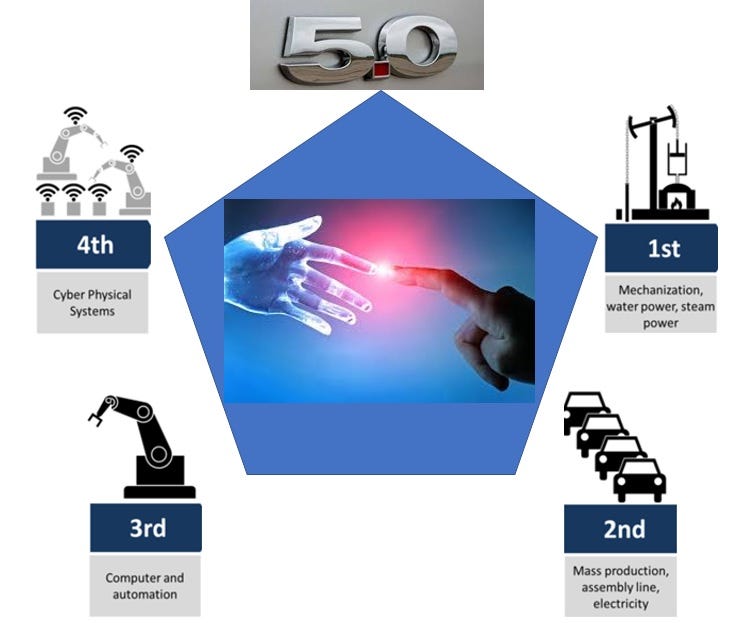The world has been experiencing the Fourth Industrial Revolution, also known as Industry 4.0, since the mid-2010s. According to the World Economic Forum, this revolution is defined by the mixture of artificial intelligence (AI), advanced robotics, additive manufacturing (3D printing), and the Internet of Things (IoT) to improve manufacturing efficiency.
Machine learning is ushering in a new era of the future industrial revolution. What some experts refer to as “Industry 5.0” has already commenced, with AI-enabled tools and platforms taking on monotonous, low-value tasks that would otherwise detract from human productivity. Here’s a look at what Industry 5.0 might look like — and how machine learning is driving this transformation.
Industry 1.0 to 5.0
The original Industrial Revolution, which occurred in the late 18th century in Britain, is referred to as Industry 1.0. This was the first time that mass production was made possible through the use of water and steam power rather than manual physical labor from humans and animals. Manufacturing used the power of machines to completely transform society.
Then, a century later, came Industry 2.0. Assembly lines, as well as the use of oil, gas, and electric power, and advanced communications like the telephone, allowed the manufacturing industry to advance. Automation entered the manufacturing process to a small extent, allowing mass production to grow and advance.
Industry 3.0 refers to the introduction of computers in the mid-twentieth century, when digitization, telecommunications, and data analysis had an even greater impact on manufacturing. Automation progressed with factory digitization and the utilization of programmable logic controllers (PLCs), which automated even more processes and began collecting basic data.
This leads us to Industry 4.0, also known as the Fourth Industrial Revolution. Sources differ on when Industry 4.0 officially began, but between 2011 and 2016, manufacturing experienced a new wave of technological advancement brought about by data, increased automation, and the development of smart machines and smart factories. We are still witnessing a radical shift in how the internet connects machines — a shift that some are already referring to as Industry 5.0.
Are We Witnessing Industry 5.0?
Some experts believe that the COVID-19 pandemic has hastened the transition to Industry 5.0.
The Fifth Industrial Revolution is shifting from a focus on the digital experience to one in which humans are once again in charge, wrote Dan Gamota, Jabil’s VP of manufacturing, technology, and innovation. The results will combine automation’s skill and speed with humans’ critical and creative thinking.
According to the European Union, Industry 5.0 will prioritize worker well-being and take a societal approach to the manufacturing sector. The new industrial revolution will be human-centric, influenced by the requirement to reduce our carbon emissions as well as the need for workers to find new ways to engage, connect, and complete their work.
We are already seeing signs of this change to some extent. In what is now known as the Great Resignation, nearly 20 million employees voluntarily resigned between April and August of 2021. These employees cited burnout and stress as two of their primary reasons for leaving. Many employees required time off to re-calibrate and recharge, while others faced home stress such as caregiving, homeschooling, or coping with feelings of isolation.
Technology’s scope in Industry 5.0
Despite the human-centric approach that experts forecast for the fifth industrial revolution, technology will still drive this change. Machine learning offers a solution to covering monotonous, manual tasks that can lead to worker burnout with bots and AI-powered tools that have the potential to reduce worker stress while increasing productivity.
Shortly, the convergence of human cognition and artificial intelligence is poised to produce a slew of new use cases, Gamota wrote. There is a vast potential when we consider what is possible when people and collaborative robots, virtual assistants, digital twins, and avatars work side by side or enjoy truly immersive experiences in ways that were not fully imagined before Covid-19, says the author.
AI-powered bots, in addition to AR and VR machine learning, are expected to play a significant role in Industry 5.0. These technologies enable manufacturers to optimize results while reducing the need for human intervention in assembly and production.




